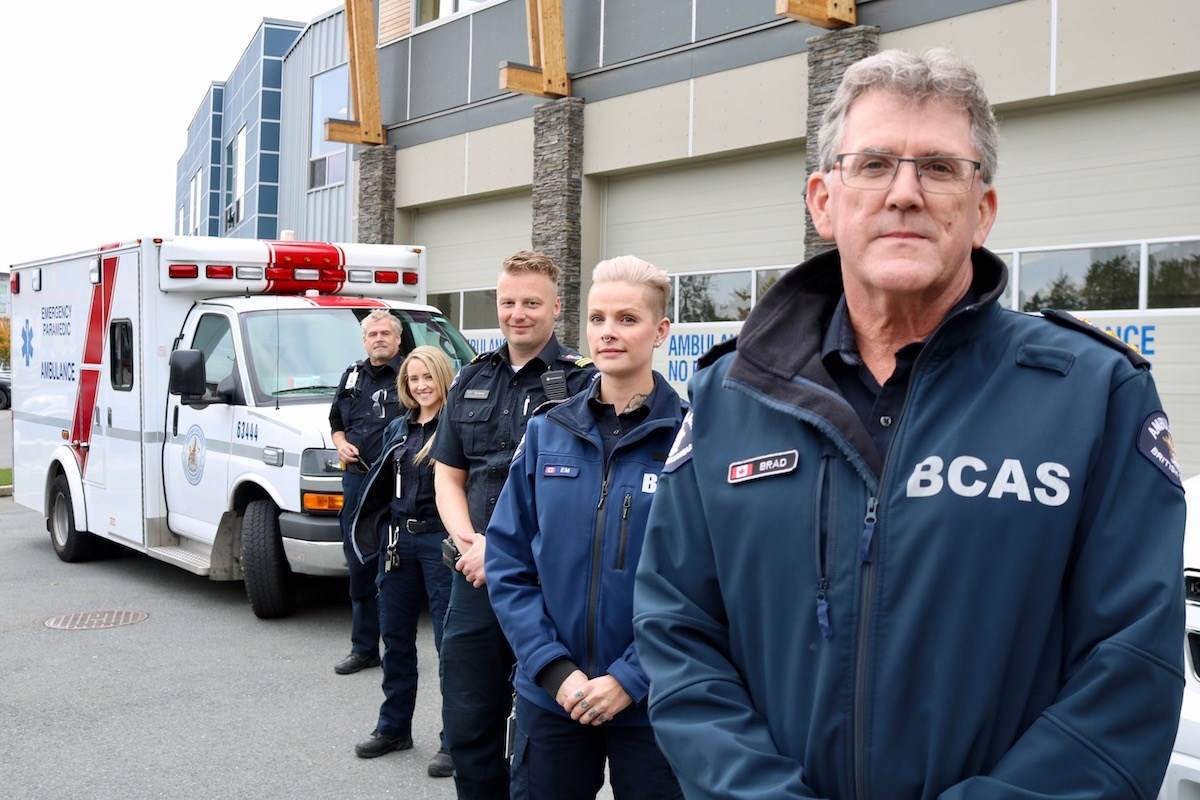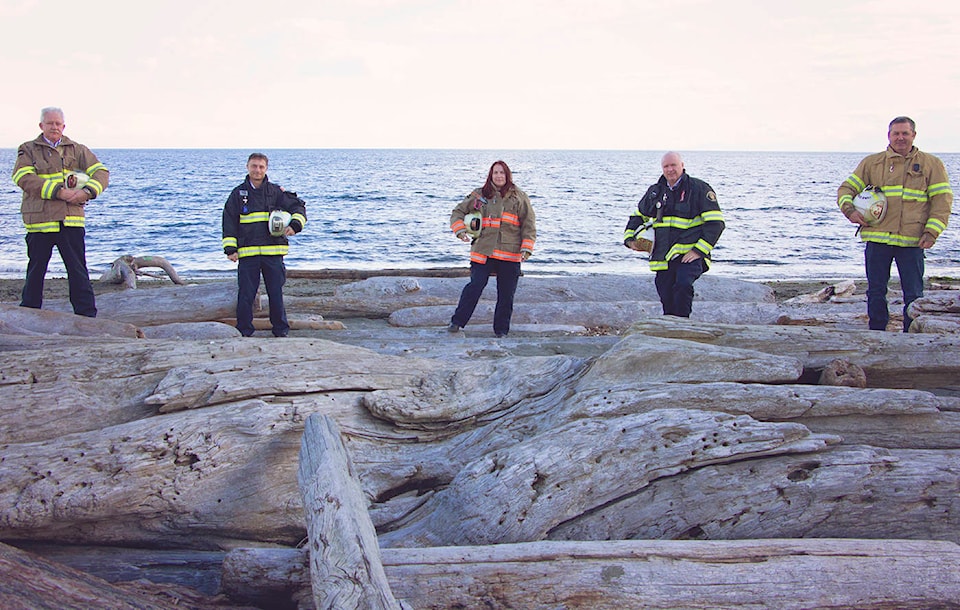What happens in an emergency if there’s no one left to call?
It’s a situation first responders on the West Shore never want to see. So when the COVID-19 pandemic hit, they sprang into action. But this time, how they responded was forced to change.
“We don’t get the option to work from home,” said View Royal Fire Chief Paul Hurst. “Collectively, we all realized on the West Shore if one of our departments fell, then it would be incumbent on the others.”
It’s a sentiment echoed by all five West Shore fire chiefs as they pointed to the mainland where a hall was crippled after a coronavirus exposure sidelined many of its firefighters.
“We’re not letting our guard down,” added Colwood Fire Chief John Cassidy.
With their doors shut to the public, operations have changed for the foreseeable future. Creating roadblocks for the people they are there to protect was not an option and that has created challenges.
While crews may not always look like they’re following strict protocols, they’re there to do a job and keep everyone safe.
“We don’t want people to think we’re not available,” said Stephanie Dunlop, Metchosin Fire Chief and emergency program coordinator. “Because we’re so connected with our community, it’s ensuring they have the tools to stay safe.”
B.C. Emergency Health Services (BCEHS) is also working hard to keep its dispatchers and paramedics safe. With three dispatch centres in the province – Langford, Vancouver and Kamloops – an outbreak at dispatch could be crippling.
Like many, BCEHS faced a shortage of personal protective equipment and was forced to find alternatives while keeping up with demand. Early supplies of N95 masks ran out but 3M Elastomeric Facepiece Respirators (EFR) had already been sourced. However, that was no small task.
“It’s not just a matter of giving someone a mask and saying ‘here’s your new mask’ … We had to fit test the entire province for the new EFRs,” said Brad Cameron, BCEHS superintendent of patient care delivery for Greater Victoria.
Paramedics were then fitted again for another N95 alternative – as well as being outfitted with gowns, gloves, eye protection and more.
Unlike sterile environments in hospitals, members of B.C. Ambulance Service are going into homes where there is an “enormous viral load.”
“It’s not the same environment,” Cameron explained, adding paramedics can’t risk cross-contaminating their ambulance or emergency rooms.
This means paramedics are suiting up differently for calls and it’s creating some challenges. “You sweat like you’re standing in a shower,” Cameron said of the summer months. “It’s extremely uncomfortable.”
And while paramedics are gearing up, they’re often faced with family members or the person who has called them, demanding they drop the extra protocols because the patient doesn’t have COVID.
“We don’t know that and we can’t take a risk,” Cameron said. “They get quite angry and take it out on the paramedics … over time it wears on the paramedics.”
With 30 years of experience on the street as a paramedic, Cameron has never seen anything like this. “It has added a level of complexity our paramedics have never seen before.”
READ MORE: Is COVID-19 a sign of things to come?
Volunteers
Over at the fire halls, the West Shore departments rely on volunteer members to round out staffing. But when the pandemic hit, the departments were forced to look at how they were responding to calls and find ways to limit potential exposures. For View Royal, that meant changing the way the hall was staffed and shifting to a day and night crew. “So we wouldn’t have to call people in from home,” Hurst explained.
Colwood took a similar approach, but as Cassidy said, the departments didn’t only have their members to worry about.
“One exposure now ripples out and exposes families of our members … COVID has affected the department in many significant ways.”
And when a department is entirely run by volunteers, as it is in Highlands, that means firefighters have tough choices to make.
“It’s hard to rely on people to show up,” said emergency coordinator and Fire Chief Dean Ford. Members are ultimately making the decision to put their families at risk every time they go on a call. But most have stepped up and Ford said the added safety precautions – such as temperature checks before entering the halls and more stringent cleaning procedures – have helped alleviate some of that stress.
None of the fire departments, nor the West Shore RCMP, have had a member test positive with COVID-19. Of 4,500 provincial BCEHS members, only eight have test positive (one on the Island) and seven of those members contracted the virus from family members – not on the job.
Changes to response
Firefighters across the West Shore have also adapted how they respond to calls. Traditionally, everyone who could, would respond. But when COVID hit that changed. The fire departments limited the number of members going on calls, who was responding to certain calls, how many members went and even the types of calls they would send trucks to. All of this was done to limit the number of members who could be potentially exposed.
For first responders, physical distancing isn’t usually an option when close personal contact is required for saving someone’s life, detaining a suspect or even just speaking with someone needing emergency response.
| Insp. Todd Preston, Officer in Charge of the West Shore RCMP, thanked the community for its support as it has helped officers get through the challenging year 2020 has been. (Katherine Engqvist/News Staff) |
“That’s certainly weighed on the mental psyche of our members,” explained Insp. Todd Preston, Officer in Charge of the West Shore RCMP.
In an effort to limit potential exposures, police also changed how they are responding to calls with certain members helping residents not requiring one-on-one response – for example, starting a file on a minor crash.
The detachment also shifted section members to areas they were seeing the biggest need. When the pandemic hit, West Shore RCMP saw a dramatic increase in thefts from pharmacies as well as grocery and liquor stores. Members were moved from other duties and strategically places outside these businesses. They heard from loss-prevention officers in-store that thieves were wheeling carts of stolen product out of the store but would stop in their tracks once they saw the officers.
ALSO READ: Mental Health – A look at a fractured system
Call volumes
While the RCMP saw an initial uptick in specific calls, the fire departments and BCEHS saw their call volumes drop when the pandemic hit.
On average, BCEHS sees about 1,400 calls a day across the province. While 2020 started as a typical year – with an expected increase in calls from the year before – when the pandemic hit, they too saw a dip with more people staying home. But their call volume is back up to that average after a spike in mental health calls during the summer.
And with cold, dark days on the horizon, first responders are worried about the mental health of the community.
“I am bracing,” Preston said, adding the detachment saw a dramatic spike in August for calls relating to mental health and well-being. “I don’t think that’s going to get any better.”
Firefighters have also seen a spike. During the first 12 weeks of the pandemic call volumes were dramatically down for firefighters – due to limiting medical aid response – but Cassidy said Colwood Fire Rescue is only tracking about 20 per cent behind last year – which was a record year for calls. And they’re not unique in that.
“We’re right back up to our historic numbers,” Hurst added of View Royal.
Training
With call volumes on the rise, keeping up with demand has had another set of challenges. After approximately six months without training, the departments have faced challenges in keeping up their skillsets and getting new recruits certified to respond.
“We were right in the middle of a recruitment class,” explained Langford Fire Chief Chris Aubrey, noting training is essential in keeping their numbers up as they lose volunteers to other commitments.
It’s a situation that’s not unique to the fire departments and many community organizations have faced similar challenges, he said. While some training can be done online, some needs to be done in-person.
“It’s tough to do live fire online,” Aubrey said, and someone who isn’t certified can’t be sent into a burning building.
Camaraderie
Training isn’t the only activity at the halls that has been sidelined.
Letting the members know they’re appreciated has been a challenge with fun events, community meals and gatherings all cancelled. Aubrey noted a member of Langford Fire Rescue is celebrating 35 years of service but as the department has more than 65 members, they aren’t able to host their annual appreciation dinner.
None of the departments are.
Making sure that camaraderie stays intact has been challenging but it’s forced creativity. “In the fire service, we’ve relied on traditions … now’s the time to create new traditions,” Aubrey explained.
Halloween is a good example of that noted Dunlop. With the traditional bonfires and other events at the halls cancelled, they were forced to come up with something new.
Over at the West Shore RCMP, community support has helped members get through. The detachment serves seven communities including five municipalities (View Royal, Colwood, Metchosin, Langford and Highlands), as well as the Songhees and Esquimalt Nations.
“They have just been unwavering in their support,” Preston said, noting residents have stopped by with cards and other gestures of appreciation. Officers have even had community members pay for their orders in drive-thru lineups, something they like to pay forward by paying for the next order in line. Like the community, officers are mentally exhausted and Preston said the little things help.
But at the end of the day, as Dunlop said, first responders are here to give back to the community.
READ MORE: Best of the WestShore Award results
Do you have a story tip? Email: vnc.editorial@blackpress.ca.
Follow us on Twitter and Instagram, and like us on Facebook.

